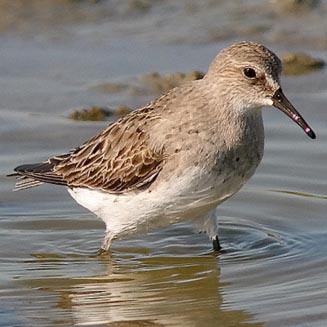|
Calidris fuscicollis
(White-rumped sandpiper)
Witrugstrandloper [Afrikaans]; Bonapartes-strandloper
[Dutch]; Bécasseau de Baird [French]; Bairds strandläufer [German]; Pilrito de
Bonaparte [Portuguese]
Life
> Eukaryotes >
Opisthokonta
> Metazoa (animals) >
Bilateria >
Deuterostomia > Chordata >
Craniata > Vertebrata (vertebrates) > Gnathostomata (jawed
vertebrates) > Teleostomi (teleost fish) > Osteichthyes (bony fish) > Class:
Sarcopterygii (lobe-finned
fish) > Stegocephalia (terrestrial
vertebrates) > Tetrapoda
(four-legged vertebrates) > Reptiliomorpha > Amniota >
Reptilia (reptiles) >
Romeriida > Diapsida > Archosauromorpha > Archosauria >
Dinosauria
(dinosaurs) > Saurischia > Theropoda (bipedal predatory dinosaurs) >
Coelurosauria > Maniraptora > Aves
(birds) >
Order: Charadriiformes > Family: Scolopacidae
 |
|
|
White-rumped sandpiper, California, USA. [photo
Jeff Poklen
©] |
|
Distribution and habitat
Breeds in Arctic Canada from Baffin Island to Mackenzie
Island, heading south in the non-breeding season to South America, but it is
also a rare vagrant to Europe. Australasia and Africa, including southern
Africa. Here it is has occasionally been sighted on the coast and further inland
in central and northern Namibia, the coast of the Western and Eastern Cape and
the North-West Province. It generally prefers coastal and inland wetlands,
especially estuarine mudflats, sewage works and coastal lagoons.
Food
It mainly forages by wading through water and probing the
mud, often in flocks with Little stints and
Curlew sandpipers.
References
-
Hockey PAR, Dean WRJ and Ryan PG 2005. Roberts
- Birds of southern Africa, VIIth ed. The Trustees of the John Voelcker
Bird Book Fund, Cape Town.
|
